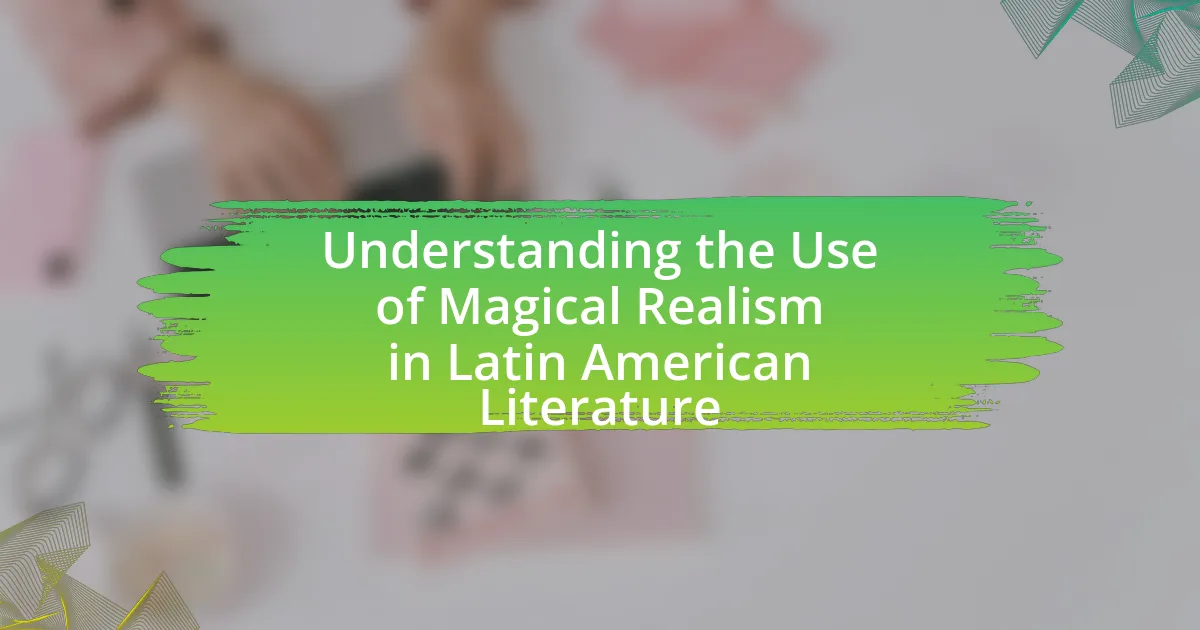Intertextuality in the works of Gabriel García Márquez refers to the intricate connections his narratives establish with other texts, enriching their meaning through references to folklore, history, and literature. This article explores how intertextuality manifests in Márquez’s storytelling, particularly in “One Hundred Years of Solitude,” where biblical allusions and Latin American history deepen thematic complexity. Key influences on his writing, such as “Don Quixote” and the works of Borges and Cortázar, are examined, alongside the significance of cultural context in shaping intertextual references. The article also discusses how these intertextual elements enhance themes of solitude, identity, and the cyclical nature of history, ultimately illustrating the profound impact of intertextuality on the reader’s experience and understanding of Márquez’s literature.

What is Intertextuality in the Works of Gabriel García Márquez?
Intertextuality in the works of Gabriel García Márquez refers to the way his narratives engage with and reference other texts, creating a rich tapestry of meaning. Márquez often incorporates elements from folklore, history, and literature, blending them into his magical realism style. For instance, his novel “One Hundred Years of Solitude” draws on biblical stories, Latin American history, and literary traditions, which enhances the depth of his storytelling. This intertextual approach allows readers to uncover layers of significance and connections between Márquez’s work and broader cultural narratives, demonstrating how literature can reflect and shape societal contexts.
How does intertextuality manifest in Márquez’s narratives?
Intertextuality in Gabriel García Márquez’s narratives manifests through the incorporation of historical, literary, and cultural references that enrich the text. For example, in “One Hundred Years of Solitude,” Márquez alludes to biblical stories and Latin American history, creating a dialogue between his fictional world and real events. This technique not only deepens the reader’s understanding of the characters and themes but also situates Márquez’s work within a broader literary tradition, as seen in his use of magical realism, which draws on various literary influences, including European modernism and Latin American folklore. Such intertextual connections enhance the complexity of his narratives and invite readers to explore multiple layers of meaning.
What are the key texts that influence Márquez’s writing?
Gabriel García Márquez’s writing is significantly influenced by key texts such as “Don Quixote” by Miguel de Cervantes, “One Hundred Years of Solitude” itself, and the works of Latin American writers like Jorge Luis Borges and Julio Cortázar. “Don Quixote” introduces themes of magical realism and the interplay between reality and fiction, which are central to Márquez’s narrative style. His own “One Hundred Years of Solitude” reflects the influence of oral storytelling traditions, while Borges and Cortázar contribute to the exploration of time and identity in Latin American literature. These texts collectively shape Márquez’s unique voice and thematic concerns, establishing a rich intertextual framework in his works.
How do references to other works enhance the themes in Márquez’s stories?
References to other works enhance the themes in Márquez’s stories by creating a rich tapestry of intertextuality that deepens the reader’s understanding of his narratives. For instance, Márquez often alludes to biblical texts, which reinforces themes of fate, morality, and the cyclical nature of history. In “One Hundred Years of Solitude,” the parallels to the story of Adam and Eve highlight the themes of innocence and the loss thereof, while references to Latin American history underscore the inevitability of repetition in societal patterns. These intertextual connections invite readers to explore broader cultural and philosophical questions, enriching the thematic complexity of his work.
Why is intertextuality significant in understanding Márquez’s literature?
Intertextuality is significant in understanding Márquez’s literature because it reveals the interconnectedness of his narratives with broader literary traditions and cultural contexts. This technique allows readers to see how Márquez draws upon and reinterprets elements from various sources, such as folklore, history, and other literary works, enriching the themes and motifs present in his stories. For instance, in “One Hundred Years of Solitude,” Márquez weaves biblical references and Latin American history into the fabric of the narrative, creating a multi-layered text that invites deeper analysis. This interplay not only enhances the reader’s comprehension of his work but also situates it within a larger dialogue of literary and cultural discourse, demonstrating how Márquez’s writing is both a product of and a response to the literary canon.
What role does cultural context play in intertextual references?
Cultural context significantly influences intertextual references by shaping the meanings and interpretations of texts. In Gabriel García Márquez’s works, for instance, the cultural backdrop of Latin America, including its history, traditions, and social issues, informs the way readers understand allusions to other literary works, folklore, and historical events. This context allows readers to grasp deeper layers of meaning, as Márquez often weaves elements of magical realism with cultural narratives, making intertextual references resonate more profoundly within the specific cultural framework. The interplay between cultural context and intertextuality enhances the richness of Márquez’s storytelling, as evidenced by his frequent incorporation of local myths and historical figures, which are better appreciated by audiences familiar with the cultural nuances of Latin America.
How does intertextuality contribute to the reader’s experience?
Intertextuality enhances the reader’s experience by creating layers of meaning through references to other texts, enriching the narrative. In Gabriel García Márquez’s works, such as “One Hundred Years of Solitude,” intertextuality allows readers to draw connections between his storytelling and historical, cultural, or literary contexts, deepening their understanding of themes like solitude and magical realism. This technique invites readers to engage actively with the text, as they recognize allusions to biblical stories, Latin American history, and other literary works, which collectively shape their interpretation and emotional response.
What are the different types of intertextuality found in Márquez’s works?
Gabriel García Márquez’s works exhibit several types of intertextuality, including allusion, parody, and pastiche. Allusion is prevalent as Márquez references historical events, literary figures, and cultural myths, enriching his narratives with deeper meanings. For instance, in “One Hundred Years of Solitude,” he alludes to biblical stories and Latin American history, creating a layered text that resonates with readers familiar with these references. Parody is also present, where Márquez often critiques societal norms and literary conventions, as seen in “The Autumn of the Patriarch,” which satirizes authoritarian regimes. Lastly, pastiche is utilized in his blending of various genres and styles, merging magical realism with elements of journalism and folklore, evident in “Chronicle of a Death Foretold.” These intertextual strategies enhance the complexity and richness of Márquez’s storytelling, allowing for multiple interpretations and connections.
How does allusion function in Márquez’s storytelling?
Allusion in Márquez’s storytelling serves to deepen thematic resonance and enrich narrative layers. By referencing historical, literary, and cultural texts, Márquez creates a tapestry of meaning that invites readers to engage with the broader context of his characters’ experiences. For instance, in “One Hundred Years of Solitude,” the allusions to biblical stories and Latin American history enhance the magical realism, allowing readers to draw parallels between the fictional world of Macondo and real-world events. This technique not only situates his work within a larger literary tradition but also prompts critical reflection on identity, power, and the cyclical nature of history.
What are some notable examples of allusion in his major works?
Gabriel García Márquez employs notable allusions in his major works, particularly in “One Hundred Years of Solitude” and “Chronicle of a Death Foretold.” In “One Hundred Years of Solitude,” Márquez alludes to biblical themes, such as the story of Cain and Abel, which reflects the conflict between the Buendía brothers. Additionally, the character of Melquíades serves as an allusion to the figure of the wandering Jew, symbolizing knowledge and the cyclical nature of time. In “Chronicle of a Death Foretold,” Márquez alludes to the concept of honor and fate, echoing classical tragedies, which underscores the inevitability of Santiago Nasar’s death. These allusions enrich the narrative and deepen the thematic complexity of his works.
How do these allusions shape character development?
Allusions in Gabriel García Márquez’s works significantly shape character development by providing deeper context and enhancing the complexity of characters. For instance, references to historical events, mythological figures, or literary works allow readers to understand characters’ motivations and backgrounds more profoundly. In “One Hundred Years of Solitude,” the allusions to biblical stories and Latin American history illustrate the cyclical nature of time and the characters’ struggles, thereby enriching their emotional depth and existential dilemmas. This intertextuality not only situates characters within a broader cultural narrative but also invites readers to draw parallels between the characters’ experiences and those of historical or mythical figures, thus fostering a more nuanced understanding of their development.
What is the role of parody and pastiche in Márquez’s literature?
Parody and pastiche in Gabriel García Márquez’s literature serve to critique and reinterpret existing narratives and cultural tropes. By employing parody, Márquez often highlights the absurdities within societal norms and literary conventions, allowing readers to question established truths. Pastiche, on the other hand, enables him to blend various styles and genres, creating a rich tapestry that pays homage to literary predecessors while simultaneously subverting their intentions. For instance, in “One Hundred Years of Solitude,” Márquez utilizes elements of magical realism alongside traditional storytelling, effectively merging different literary influences to create a unique narrative voice. This interplay of parody and pastiche not only enriches his storytelling but also invites deeper engagement with the text, encouraging readers to explore the complexities of identity, culture, and history.
How does Márquez use parody to critique societal norms?
Márquez employs parody to critique societal norms by exaggerating and subverting traditional narratives and cultural expectations. Through his use of hyperbolic characters and absurd situations, he highlights the contradictions and absurdities inherent in societal behaviors and beliefs. For instance, in “One Hundred Years of Solitude,” the portrayal of the Buendía family reflects the cyclical nature of history and the folly of human endeavors, effectively mocking the idea of progress and the weight of tradition. This technique allows Márquez to expose the flaws in social structures and the often ridiculous nature of human aspirations, thereby prompting readers to question the validity of these norms.
What are the effects of pastiche on the narrative style?
Pastiche significantly influences narrative style by blending various literary forms and genres, creating a rich tapestry of intertextual references. This technique allows authors to pay homage to previous works while simultaneously critiquing or reinterpreting them, which enhances the depth and complexity of the narrative. For instance, Gabriel García Márquez employs pastiche in his storytelling by integrating elements of magical realism with traditional narrative forms, thereby enriching the reader’s experience and inviting multiple interpretations. This approach not only showcases Márquez’s literary influences but also reflects the cultural and historical contexts that shape his narratives, ultimately leading to a more layered and engaging storytelling experience.
How does intertextuality influence the themes in Márquez’s works?
Intertextuality significantly influences the themes in Gabriel García Márquez’s works by creating a dialogue between his narratives and existing literary, historical, and cultural texts. This interplay enriches his exploration of themes such as solitude, love, and the cyclical nature of history. For instance, Márquez often references biblical stories, classical literature, and Latin American folklore, which deepens the reader’s understanding of his characters’ experiences and societal contexts. The use of intertextuality allows Márquez to weave complex layers of meaning, as seen in “One Hundred Years of Solitude,” where the cyclical nature of time reflects both historical events and mythological elements, illustrating the inextricable link between personal and collective histories.
What themes are most commonly explored through intertextual references?
Common themes explored through intertextual references include magic realism, the cyclical nature of time, and the intersection of personal and political histories. In Gabriel García Márquez’s works, magic realism often manifests through the blending of fantastical elements with everyday life, as seen in “One Hundred Years of Solitude,” where the extraordinary becomes part of the ordinary. The cyclical nature of time is illustrated through repetitive historical events and family legacies, emphasizing the idea that history is not linear but rather a series of recurring patterns. Additionally, Márquez frequently intertwines personal narratives with broader political contexts, reflecting the complexities of Latin American identity and history, as evidenced in “Chronicle of a Death Foretold,” where individual actions are deeply connected to societal norms and political realities.
How does intertextuality enhance the theme of magical realism?
Intertextuality enhances the theme of magical realism by creating a dialogue between texts that deepens the reader’s understanding of reality and fantasy. In Gabriel García Márquez’s works, such as “One Hundred Years of Solitude,” references to historical events, myths, and other literary works blur the lines between the ordinary and the extraordinary. This layering of narratives allows readers to perceive the magical elements as integral to the characters’ lived experiences, reinforcing the idea that magic is a natural part of their reality. For instance, Márquez’s incorporation of Latin American history and folklore provides a cultural context that legitimizes the fantastical occurrences, making them resonate more profoundly with the reader.
What connections can be drawn between intertextuality and the theme of solitude?
Intertextuality and the theme of solitude are interconnected through the way literary texts reference and reshape each other to explore the human experience of isolation. In Gabriel García Márquez’s works, such as “One Hundred Years of Solitude,” the narrative often reflects solitude not only as a personal condition but also as a collective experience shaped by historical and cultural contexts. For instance, the cyclical nature of solitude in the Buendía family mirrors the broader themes of loneliness found in other literary works, such as those by Franz Kafka or Virginia Woolf, where characters grapple with existential isolation. This intertextual dialogue enhances the understanding of solitude by situating it within a larger literary framework, demonstrating how different authors articulate similar themes through their unique narratives.
How does intertextuality reflect Márquez’s views on history and identity?
Intertextuality in Gabriel García Márquez’s works reflects his views on history and identity by intertwining personal narratives with broader historical contexts. Márquez often incorporates elements from Latin American history, folklore, and literature, creating a tapestry that emphasizes the cyclical nature of time and the interconnectedness of individual and collective identities. For instance, in “One Hundred Years of Solitude,” the Buendía family’s saga mirrors the tumultuous history of Colombia, illustrating how personal experiences are shaped by historical events. This blending of texts and contexts underscores Márquez’s belief that identity is not static but rather a product of historical forces and cultural narratives, reinforcing the idea that understanding one’s identity requires an awareness of the past.
What historical texts does Márquez engage with in his narratives?
Gabriel García Márquez engages with various historical texts in his narratives, notably including “The Conquest of America” by Bartolomé de las Casas and “The History of the Indies.” These texts provide a foundation for Márquez’s exploration of colonialism, identity, and the complexities of Latin American history. By incorporating these historical accounts, Márquez critiques the impact of colonization and reflects on the cultural and social ramifications that persist in contemporary society. His use of these texts enhances the depth of his storytelling, allowing readers to connect historical events with the magical realism that characterizes his work.
How does this engagement shape the portrayal of Latin American identity?
Engagement with intertextuality in Gabriel García Márquez’s works shapes the portrayal of Latin American identity by weaving together diverse cultural narratives and historical contexts. This blending of texts allows for a multifaceted representation of identity that reflects the complexities of Latin American experiences, such as colonialism, social injustice, and magical realism. For instance, Márquez’s use of folklore and historical events in “One Hundred Years of Solitude” illustrates how personal and collective histories intertwine, creating a rich tapestry that defines Latin American identity. This approach not only highlights the region’s unique cultural heritage but also critiques socio-political realities, thereby reinforcing the notion that Latin American identity is dynamic and continually evolving.
What practical insights can be gained from studying intertextuality in Márquez’s works?
Studying intertextuality in Gabriel García Márquez’s works reveals how his narratives are interconnected with historical, cultural, and literary contexts, enhancing the reader’s understanding of themes such as solitude, power, and magical realism. For instance, Márquez often references biblical texts and Latin American history, which deepens the exploration of identity and societal issues within his stories. This intertextual approach allows readers to recognize the influence of other literary figures, such as William Faulkner and Virginia Woolf, thereby enriching the interpretation of Márquez’s unique style and thematic concerns.
How can readers apply an understanding of intertextuality to enhance their literary analysis?
Readers can apply an understanding of intertextuality to enhance their literary analysis by recognizing the connections between texts and how these relationships influence meaning. By identifying references, allusions, and thematic parallels in Gabriel García Márquez’s works, readers can uncover deeper layers of interpretation that reveal the author’s commentary on culture, history, and human experience. For instance, Márquez often draws on elements of magical realism, which can be better understood through the lens of intertextuality by comparing his narratives to other literary traditions that explore similar themes, such as folklore or myth. This comparative approach allows readers to appreciate the richness of Márquez’s storytelling and the broader literary context in which he operates, ultimately leading to a more nuanced analysis of his texts.
What strategies can writers use to incorporate intertextuality in their own works?
Writers can incorporate intertextuality in their works by referencing, alluding to, or reinterpreting existing texts. This can be achieved through direct quotations, thematic parallels, or character archetypes that resonate with established literary works. For instance, Gabriel García Márquez often draws on historical events and literary traditions, blending them into his narratives to create deeper meanings. By doing so, writers can enrich their storytelling and engage readers in a dialogue with the referenced texts, enhancing the overall impact of their work.





